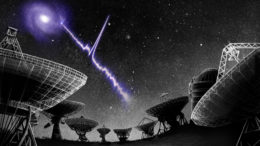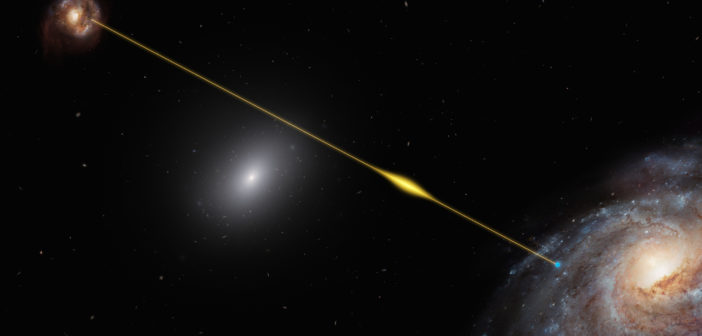In recent years, we’ve recorded hundreds of brief, powerful flashes of radio light originating from outside of our galaxy. In new work, scientists are now leveraging these enigmatic fast radio bursts to learn about the hot gas around galaxies.
An Epic Voyage

Artist’s conception of a fast radio burst originating in a distant galaxy. [Danielle Futselaar]
To reach us, this emission first passes through the source’s local environment, then through the interstellar medium (ISM) of its host galaxy, and then through that galaxy’s halo. Once free of the galaxy, the light must traverse the intergalactic medium (IGM) — potentially passing through intervening galactic halos — before it eventually enters the circumgalactic environment around the Milky Way. There, it travels through the halo and ISM of the Milky Way and finally arrives at our detectors here on Earth.
This epic voyage is fraught with obstructions: the burst emission encounters clumps of hot, ionized, and turbulent gas that slows its passage and leaves distinct imprints on the signal we eventually see. In a new study led by Stella Ocker (Cornell University), scientists have used these signatures to probe the ionized gas that lies between us and distant FRBs.

Schematic illustrating how transient radio signals travel to us. Pulsars (marked by sun symbols) lie in the galaxy, interior to the halo; their signals are affected only by the Milky Way’s interstellar matter. Fast radio bursts (marked by lightning symbol) lie in other galaxies; their signals travel through multiple different regions. [Platts et al. 2020]
Constraints from Bursts and Pulses
Ocker and collaborators combine multiple different diagnostics:
- dispersion of bursts, which occurs when different frequencies of light travel at different speeds through intervening gas
- pulse and angular broadening, or smearing in time and space due to scatter as light travels along multiple different paths through the gas
- scintillation, or twinkling of a compact source caused by turbulence in the intervening medium
To disentangle the relative contributions of the ionized gas in the different regions of the FRB’s journey, the authors took advantage of data from multiple FRBs along various lines of sight passing through different sections of our galaxy. They combined this information with further constraints from pulsars — pulsing, magnetized neutron stars — that lie within our galaxy, to better understand the density fluctuations along these varying lines of sight.
Downplaying Halo Contributions

A representation of the scattering contributions estimated by the authors for different regions of ionized gas. The scattering that occurs due to intervening galactic halos (M33 and FG–181112) is consistent with the upper limits found for the Milky Way’s halo (MW Halo), and substantially smaller than the scattering caused within the inner disk of our galaxy (MW Inner Galaxy). [Ocker et al. 2021]
Ocker and collaborators’ study suggests that galaxy halos have only a very small impact on the scattering of light in FRBs. While additional FRB and pulsar data will be helpful in constraining more lines of sight, this work provides a valuable step in disentangling different reservoirs of ionized gas to ultimately probe the density fluctuations across our universe.
Citation
“Constraining Galaxy Halos from the Dispersion and Scattering of Fast Radio Bursts and Pulsars,” Stella Koch Ocker et al 2021 ApJ 911 102. doi:10.3847/1538-4357/abeb6e

3 Comments
Pingback: From AAS NOVA : “What Fast Radio Bursts Tell Us About Galaxy Halos” | sciencesprings
Pingback: Co szybkie błyski radiowe mówią nam o halo galaktyk – PTMA Kraków
Pingback: Co szybkie błyski radiowe mówią nam o halo galaktyk – Astronomia Śląska